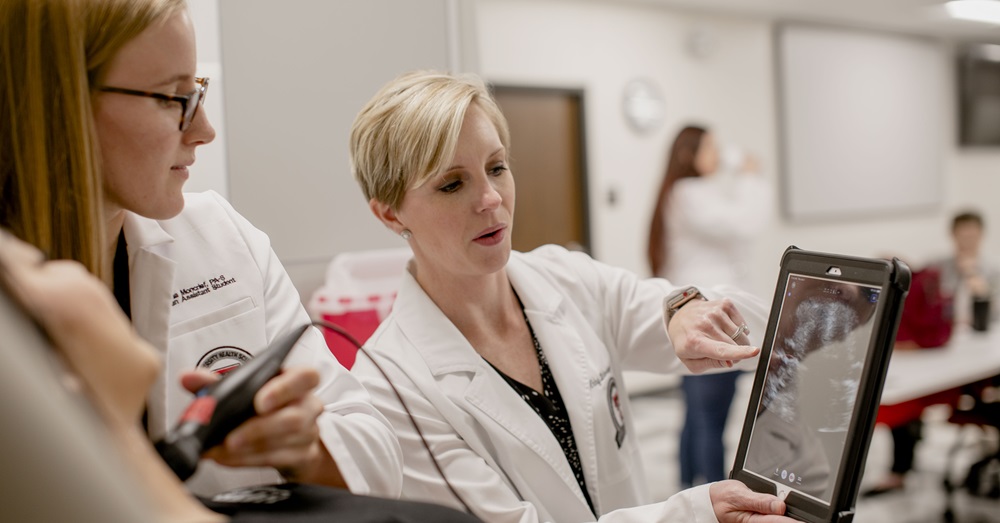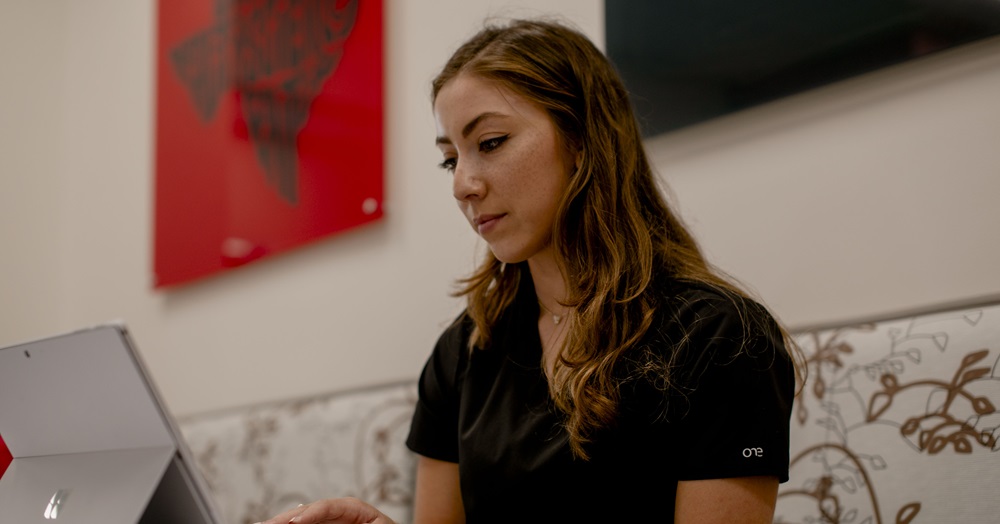PAs and Telehealth: Increasing Access to Patient Care

According to American Academy of Physician Associates, the PA profession was created to improve and expand access to health care. In the mid-1960s, physicians and educators recognized there was a shortage of primary care physicians. Thus, Eugene A. Stead Jr., MD, of the Duke University Medical Center, assembled the first class of PAs in 1965.
Just as the PA profession was created to improve patient access to medical care, so too was Telemedicine, or telehealth, created.
Abby Buterbaugh, who has practiced as a PA for 10 years, spoke with us regarding the value that her profession and telehealth has brought to patient care and relief from the burden that many health care providers, along with the entire health care system, has and continues to face.
Buterbaugh currently treats men that are incarcerated within the Texas Department of Criminal Justice System. She has been a faculty member at TTUHSC for over four years, currently serving as the Director of Didactic Education and teaching as an assistant professor in the Master of Physician Assistant Studies program.
Why Telehealth over an office visit?

Telehealth is ideal in terms of accessibility, convenience, cost and time.
Buterbaugh shares a few key points that make telehealth an ideal choice for health care services — accessibility, convenience, cost and time.
- Telemedicine increases the access to patient care, especially in West Texas. It can be difficult for people in our area or any rural area to drive to see their health care provider.
- Buterbaugh also shares that the younger generation are more comfortable with the idea of telehealth and value the accessibility and convenience of it overall.
- For some patients, it may cost more out of pocket to drive to a visit, opposed to having the appointment from home or elsewhere.
“I treat inmates through the TTUHSC Managed Care Program,” says Buterbaugh. “That is a population that would be very hard for me to go see, so I can ‘go to them’ through telehealth.”
As a provider, telehealth is a time saver for Buterbaugh, allowing her to ‘travel’ to different units across West Texas. “You can access and reach a greater patient population than you would be able to otherwise.”
The Challenges with Telehealth
telehealth has a few challenges, however — challenges that Buterbaugh views as opportunities to improve and expand a PA’s ability to treat their patients.
- “Someone with acute chest pain shouldn’t be treated via telehealth,” Buterbaugh shares as an example of a scenario in which telehealth is not the ideal form of treatment. However, even in that situation, she says it could still be successful because that patient was seen and directed to appropriate care for their symptoms. Not only that, but a large portion of the work has already been done.
- There is also a challenge to telehealth appointments in that practitioners can’t do their own physical exams. Typically, a nurse or presenter performs vital signs, and uses various peripheral devices such as examination cameras, stethoscopes, and other diagnostic tools. “I need to guide the patient and presenter to obtain physical exam findings when I am not physically there,” she says.
- Technology is great until it doesn’t work. It’s going to have errors. Sometimes you don’t have control of the issues that may arise (i.e. internet connection or equipment malfunctions).
These issues that may arise push Buterbaugh to “critically think about my diagnoses and establish relationships and environments when dealing with disruptions with lighting, sounds, or technology failures.”
“It has really pushed me for additional development as a health care provider to develop a new set of skills in patient care, and it has challenged me in a lot of positive ways when diagnosing and treating my patients,” she says.
The Upside to Telehealth
“Overall, we’ve seen a lot of success with it,” says Buterbaugh. “As PAs, there's so much we can do to help relieve the burdens that patients and health care providers face, and telehealth can help with that as well.” More time with patients leads to deeper conversation and overall a better health care experience for the patient. It offers opportunities for greater patient education and to reach areas that normally medicine cannot, ultimately increasing the medical literacy of patient populations.
For patients that are unsure regarding the ultimate efficacy of telehealth, Buterbaugh encourages them not to be scared of trying something new, noting that the whole point of telehealth is to help a patient’s health and to minimize the time treatment may take in a normal day. “Once you become comfortable, you’ll realize it’s a good thing and may prefer to use telehealth more frequently.”
Related Stories
TTUHSC School of Nursing Celebrates 10 Years of the Veteran to BSN Program
The TTUHSC School of Nursing recognized the 10-year anniversary of the Veteran to Bachelor of Science in Nursing (VBSN) program during the fall 2025 commencement ceremonies held Dec. 13 in Lubbock, Texas.
Lubbock ISD Middle School Students Become Docs for a Day
Lubbock Independent School District students from Atkins Middle School, McCool Academy and Evans Middle School became doctors for a day as the TTUHSC Student National Medical Association (SNMA) hosted Docs for a Day Nov. 10.
From Classroom to Clinic: Building the Future of Speech-Language Pathology
The Clinical Experience Course in the Speech, Language and Hearing Sciences program at TTUHSC provides students with hands-on, practical application of the theoretical knowledge learned in the classroom.
Recent Stories
Making Mental Health a Priority in the New Year
Sarah Mallard Wakefield, M.D., a psychiatrist with Texas Tech Physicians, talks about strategies to combat widespread and growing anxiety.
TTUHSC Cancer Researcher Honored by National Academy of Inventors
C. Patrick Reynolds, M.D., Ph.D., director of the School of Medicine Pediatric Cancer Research Center at TTUHSC, has dedicated his life as a researcher to developing treatments for childhood cancers.
TTUHSC School of Nursing Celebrates 10 Years of the Veteran to BSN Program
The TTUHSC School of Nursing recognized the 10-year anniversary of the Veteran to Bachelor of Science in Nursing (VBSN) program during the fall 2025 commencement ceremonies held Dec. 13 in Lubbock, Texas.
